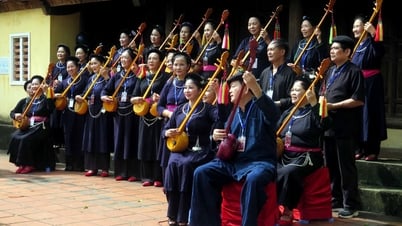( Quang Ngai Newspaper) - In the past, due to the lack of life and backwardness, many people had to go barefoot, but there was also a group of people who were allowed to wear wooden clogs. And the image of wooden clogs and bare feet in the past evokes in each of us many unforgettable memories of a time.
Memories of the past
Barefoot or barefoot means not wearing anything on the feet. Looking at sketches and photos from the French colonial period, it shows that most ancient Vietnamese people went barefoot, from adults to children, from men to women, from farmers to rickshaw pullers, postmen (delivering documents), and even soldiers.
 |
| A pair of wooden clogs is a small, simple yet very familiar item that has left its mark in the national cultural heritage. (Illustration photo) |
Not only in remote areas, even people in the suburbs of the capital also "Barefoot, shoulder-to-shoulder shirt. Le te Cho Hom, Cho Mai" (Nguyen Khoa Diem). When walking barefoot, the feet are in direct contact with the ground, if they accidentally step on thorns, gravel, or sharp objects, it will be very painful, sometimes bleeding. In coastal areas with long sand dunes, in hot summer, to cross it, people have to break off a bunch of leaves, after walking a short distance, it gets too hot, they put some leaves on the ground to rest, then continue walking. Ethnic minorities live on steep mountain slopes, with gravel and thorny paths, yet people still go barefoot, even when attending festivals or going to the forest to work on the fields, or chopping trees.
As for the Kinh people in the plains of Quang Ngai in the past, when they went to hoe the land, plow the fields, harvest, carry rice, carry firewood, they all went barefoot. There were people living in the plains who went to trade, went to "mountain trading" and walked dozens of kilometers every day still with bare feet. Goods were not yet developed, shoes were not popular, buying a pair of shoes, a pair of sandals was not cheap, and plastic sandals were not yet available, so they had to go barefoot. There were even people wearing full Ao Dai, but still went barefoot. People jokingly called going barefoot wearing... leather shoes, meaning the skin of their feet. Just like the hands, human feet are inherently very sensitive, but the feet endure like that, becoming calloused and losing sensation. However, there was also a type of item worn on the feet that was not necessarily luxurious but not necessarily humble, that was wooden clogs. In the past, there were no plastic or rubber sandals, people wore wooden clogs.
Wooden clogs in the past
| Wooden clogs seem outdated, but they also have their advantages. When wearing wooden clogs, the feet are very clean and airy, and there is a pleasant feeling when the skin of the feet comes into contact with the wooden surface, more than shoes. Clogs sometimes also evoke a sense of nobility and elegance when people wear long dresses and head scarves. Of course, because the soles are made of wood, if you wear clogs on rough places, you will easily slip and fall. |
Poet Nguyen Khoa Diem in his famous poem “Suburban Land” has the line “Absentmindedly reading sad poetry in the sound of shaving clogs”. In the past, men and women commonly wore “ao vap ho” (traditional Vietnamese dress), “ao ba ba” (traditional Vietnamese dress), and wooden clogs. Wooden clogs of course had a wooden sole, attached to a single strap to slip on the foot, which could be made of fabric, leather or something flexible and durable. Until the 60s of the last century, plastic sandals or molded rubber sandals were not yet popular. On Le Trung Dinh Street (now Le Trung Dinh Street, Quang Ngai City), there were often shops selling wooden clogs. Teachers and students wore clogs when going to school. Clogs here were probably shipped from manufacturers in the South. Men’s clogs were only tapered in the shape of a mango, with a flat surface. Women’s clogs were carved to curve along the foot, usually with high heels, and the clog strap was attached to a piece of silk or molded plastic. The surface of the clogs is sometimes painted in dark colors with decorations or natural wood color. At the bottom of the clog heel, people can attach a piece of cloth or rubber to make it comfortable to walk on, not make a clicking sound and prevent slipping. This is the type of clog that is mass produced for sale.
Wooden clogs are available, but not everyone has the money to buy them, so everyone can make them themselves. The tool to carve clogs is sometimes just a machete, if there is a saw, chisel, plane... then it is even better. A rectangular piece of wood is carved, shaped to fit the foot, the top surface is left flat, the bottom surface is carved with a heel, the corners at the toe are trimmed so that when walking, you find a piece of cloth or leather cut into a rectangle to make a strap, put a small piece of tin as a belt, and hammer in small, wide nails, and you have a pair of wooden clogs to wear. Any type of wood can be used to make clogs, it can be good wood, famous wood, or soft, spongy and light wood. The thickness of wooden clogs is usually about 5cm.
Looking at ancient paintings, we can see that the ancient Japanese, in addition to the famous kimono, also used wooden clogs like the Vietnamese. Polite, but there were times when having shoes, sandals or clogs could not be polite. That was when having to wade across rivers, streams, or walk on muddy roads, the only way was to take off the shoes or clogs, tie them around the waist and walk. There were also times when the road was not muddy but still inconvenient. Like in the work "Tất đèn" by Ngô Tất Tố, during the French colonial period, Mr. Nghi Que had a pair of Chí Long shoes, often fell asleep in parliament meetings, so he was called Nghi Gặt. When falling asleep on the table, he often took his feet out of his shoes and put them on the chair, afraid that the shoes he took off while sleeping would be stolen, so he put them around his waist to be sure. In the past, wearing beautiful clogs could be like that: Take your feet out of your clogs, fall asleep, be careful when you wake up and put your feet down to see only dirt!
Wearing clogs sometimes requires tact. When I was a teenager, my brother and I enjoyed carving clogs to wear, and found them very "stylish". My uncle saw this and scolded us: "It is impolite to wear clogs in front of adults!" Because in the past, the sound of clogs was only used by elders as a way to show off power, and everyone was afraid.
CAO CHU
RELATED NEWS:
Source




![[Photo] National Assembly Chairman Tran Thanh Man receives First Vice Chairman of the Federation Council of Russia](https://vphoto.vietnam.vn/thumb/1200x675/vietnam/resource/IMAGE/2025/9/2/3aaff46372704918b3567b980220272a)

![[Photo] National Assembly Chairman Tran Thanh Man meets with First Secretary and President of Cuba Miguel Diaz-Canel Bermudez](https://vphoto.vietnam.vn/thumb/1200x675/vietnam/resource/IMAGE/2025/9/2/c6a0120a426e415b897096f1112fac5a)
![[Photo] Lao President Thongloun Sisoulith and President of the Cambodian People's Party and President of the Cambodian Senate Hun Sen visit the 95th Anniversary Exhibition of the Party Flag Lighting the Way](https://vphoto.vietnam.vn/thumb/1200x675/vietnam/resource/IMAGE/2025/9/2/3c1a640aa3c3495db1654d937d1471c8)






























































































Comment (0)